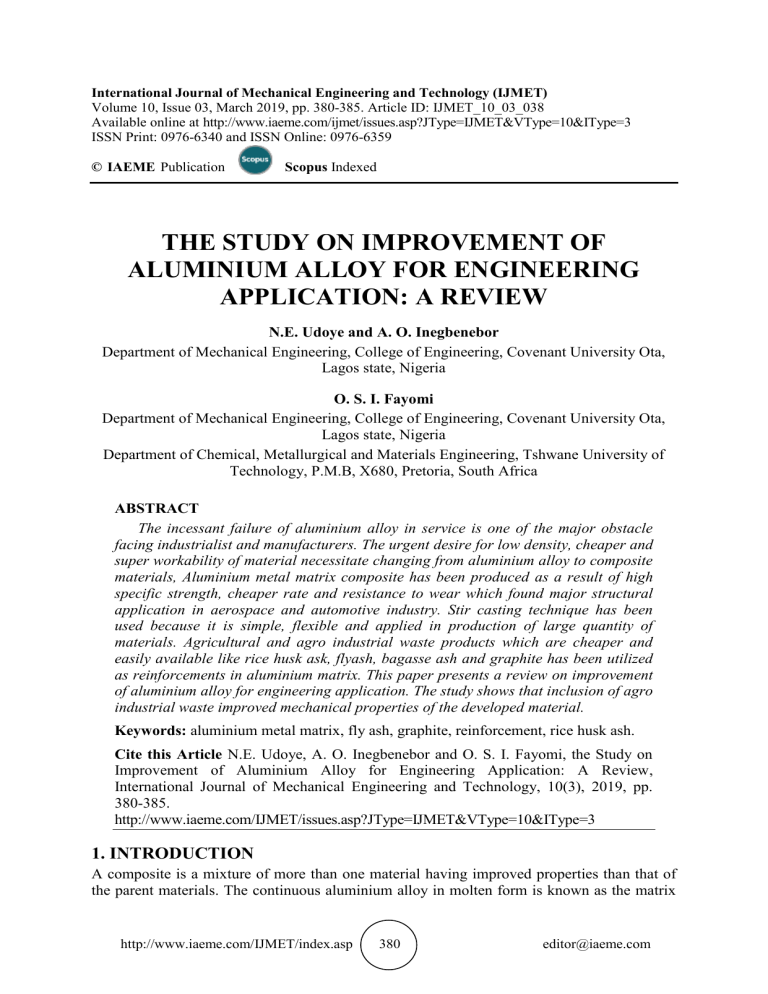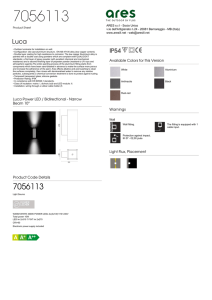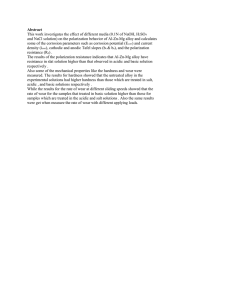THE STUDY ON IMPROVEMENT OF ALUMINIUM ALLOY FOR ENGINEERING APPLICATION: A REVIEW
advertisement

International Journal of Mechanical Engineering and Technology (IJMET) Volume 10, Issue 03, March 2019, pp. 380-385. Article ID: IJMET_10_03_038 Available online at http://www.iaeme.com/ijmet/issues.asp?JType=IJMET&VType=10&IType=3 ISSN Print: 0976-6340 and ISSN Online: 0976-6359 © IAEME Publication Scopus Indexed THE STUDY ON IMPROVEMENT OF ALUMINIUM ALLOY FOR ENGINEERING APPLICATION: A REVIEW N.E. Udoye and A. O. Inegbenebor Department of Mechanical Engineering, College of Engineering, Covenant University Ota, Lagos state, Nigeria O. S. I. Fayomi Department of Mechanical Engineering, College of Engineering, Covenant University Ota, Lagos state, Nigeria Department of Chemical, Metallurgical and Materials Engineering, Tshwane University of Technology, P.M.B, X680, Pretoria, South Africa ABSTRACT The incessant failure of aluminium alloy in service is one of the major obstacle facing industrialist and manufacturers. The urgent desire for low density, cheaper and super workability of material necessitate changing from aluminium alloy to composite materials, Aluminium metal matrix composite has been produced as a result of high specific strength, cheaper rate and resistance to wear which found major structural application in aerospace and automotive industry. Stir casting technique has been used because it is simple, flexible and applied in production of large quantity of materials. Agricultural and agro industrial waste products which are cheaper and easily available like rice husk ask, flyash, bagasse ash and graphite has been utilized as reinforcements in aluminium matrix. This paper presents a review on improvement of aluminium alloy for engineering application. The study shows that inclusion of agro industrial waste improved mechanical properties of the developed material. Keywords: aluminium metal matrix, fly ash, graphite, reinforcement, rice husk ash. Cite this Article N.E. Udoye, A. O. Inegbenebor and O. S. I. Fayomi, the Study on Improvement of Aluminium Alloy for Engineering Application: A Review, International Journal of Mechanical Engineering and Technology, 10(3), 2019, pp. 380-385. http://www.iaeme.com/IJMET/issues.asp?JType=IJMET&VType=10&IType=3 1. INTRODUCTION A composite is a mixture of more than one material having improved properties than that of the parent materials. The continuous aluminium alloy in molten form is known as the matrix http://www.iaeme.com/IJMET/index.asp 380 editor@iaeme.com The Study on Improvement of Aluminium Alloy for Engineering Application: A Review while the discontinuous members used to strengthen aluminium metal is known as the reinforcement. The main function of engineering materials is to increase strength to weight ratio. In recent time, effort has been directed toward using raw materials from the industry and agricultural sector to improve metal matrix composites instead of over dependence on ceramic material such as SIC, Al2O3 that are very costly and availability cannot be assured [1-2]. The important step to fortify properties of the base metals is to improve the morphology of the material using numerous deposition methods to obtain shield against wear rate and electrochemical dilapidation [3]. The choice of composite particulate is primarily based on the solid grains constituents and metal matrix [4]. The center of attraction of numerous researchers is to use cheaper materials particularly metal matrix composite with superior properties. Aluminium metal matrix composites (AMMCs) are used greatly in temperature reading and resistance due to thermal stress. Broad based study provides the required information aluminium matrix composites have over the parent alloy. Presently, excess demand has being placed on the usage of AMMCs for various Engineering applications [5, 6]. 2. STIR CASTING Stir casting is commonly recognized methods for the production of matrix composites. It is simple, malleable and applied in production of enormous quantity of materials. It is a liquidus state system for the fabrication of metal matrix in which a distributed segment in form of ceramic particulates and fibers are mingled with a melted metal matrix using mechanical stirrer. It is very interesting to use because it permit metal handling path that reduces the overall product cost. The casting of the liquid composite is done using prepared sand mould and further treated by metal forming techniques [7]. Factors to consider in making matrix composites through stir casting route includes [8], Proper homogenous dispersal of the reinforcement To ensure wetting of the two major materials To guard against formation of porosity in the casted matrix composites [9]. 3. MECHANICAL PROPERTIES The mechanical properties of the material such as hardness, percentage elongation, fatigue strength, tensile and Impact strength need to be upgraded in order to improve its structure. Kind of reinforcement, quality of reinforcement, percentage of reinforcement and dimension are the factors considered in determining the strength of the composites. The production of a good metal matrix composite comprises of inclusion of reinforcements to improve its mechanical properties and wear rate. Narasaraju and Raju (2015) appraised the mechanical properties of A6061/ hybrid rice husk/ fly ash composites and discovered that tensile strength of matrix improved with inclusion of reinforcement to maximum of ten. Increasing the rice husk ash and decreasing fly ash percentage helps to increase the hardness of the test specimens. Furthermore, reducing the fly ash and increasing rice husk ash lead to more percentage elongation [1]. Usman et al. (2014a) fabricated Al-7%Si/ rice husk ash (RHA) and bagasse ash (BA) and examined its mechanical properties. The authors observed that RHA and BA enhanced the mechanical properties of the material to maximum of 10.2% and ultimate tensile strength increased to 7.5% respectively. However, wear test, thermal, fatigue test cycles and electrical conductivity test were not considered in the research work to properly characterize and compare the properties of the composite [10]. http://www.iaeme.com/IJMET/index.asp 381 editor@iaeme.com N.E. Udoye, A. O. Inegbenebor and O. S. I. Fayomi Usman et al. (2014b) developed aluminium alloy/ fly ash composites using stir casting technique. They observed that the reinforced aluminium matrix is more than the unreinforced aluminium alloy. The composites produced can be utilized to produce automobile engine parts such as block engine, piston, brake parts etc. [11]. Ahamed et al. (2016) fabricated and characterized aluminium/rice husk ash composite utilizing liquid stir casting. The author reported that reinforcement increment reduce the density of the material while it increases yield strength, ultimate strength and hardness of the composites [12]. Senapati et al. (2016) examined the production of MMC fortified with rice husk ash and fly ash. The developed composites with fly ash constituents have greater impact strength, compressive strength, tensile strength and hardness than rice husk ash because of presence of Al2O3 and CaO in fly ash than rice husk ash which are all better than the base alloy although metal matrix composite with rice husk have more density. Therefore, the authors deduced that fly ash gave better improved properties in comparison to rice husk [13]. Siddharth and Rao (2017) produced Al 7075/ fly ash composite and studied the mechanical characteristics, compressive stamina and the strain hardening rate. The authors observed that the hardness under different peak point and ageing time increased more than the base alloy [14]. 4. TRIBOLOGICAL PROPERTIES Aluminum–matrix composites have been accepted globally due to specific strength and stronger wear resistance. Aluminium alloy is the best material used for structural application because of its light in weight, lower density and enhanced tribological resistance. Different authors have examined wear performance of metal matrix composite which have major application in bearing, brushes and brake lining. Alaneme and Sanusi (2015) examined the microstructure and tribological behaviour of alumina, rice husk ash and graphite reinforced aluminium matrix. The authors revealed that the absent of the graphite in the composites showed greater wear vulnerability when compared with the quality of composite having graphite. However, the wear resistance reduced increment in the graphite composition to 1.5 weight percentage. The authors observed that average of composites having RHA upsurge in wear resistance with inclusion of RHA content [15]. Gladston et al. (2017) studied AA6061/ rice husk ash composite utilizing compocasting and studied the dry sliding wear characteristics of the developed matrix. The authors have revealed that RHA particulate enhanced the wear characteristics of the composites [16]. Gupta and Takhi (2015) analyzed the mechanical and tribological behaviour of aluminum metal strengthened with aluminum oxide and rice husk ash. The authors observed that reinforcement increment leads to increase in tensile strength, flexibility, hardness and wear rate [17]. Sharma et al. (2018) studied dry sliding wear behaviour of LM30 aluminium alloy/ sillimanite composites. The authors concluded that the composition of 15 wt% sillimanite revealed better wear resistance than the base LM30 alloy. Analysis of the result showed that abrasive wear was greater at low applied loads, while adhesive wear was domineering at high applied loads [18]. Kumar et al. (2018) investigated mechanical performance and wear effect of TiC and graphite reinforced aluminium alloy. The authors observed that fortifying aluminium matrix with TiC particulate improved the wear resistance. However, increasing weight percentage of TiC reinforcements in aluminium hybrid composites revealed surface cracks and porosities in microstructures [19]. Sozhamannan et al. (2018) studied wear characteristics of Al 6061/ Nano TiCp / Gr hybrid composites using stir casting technique. The authors deduced that wear rate increases by increasing coefficient of friction, applied load and sliding velocity vice versa and also the applied load and sliding velocity affect the wear volume loss in hybrid http://www.iaeme.com/IJMET/index.asp 382 editor@iaeme.com The Study on Improvement of Aluminium Alloy for Engineering Application: A Review composites [20]. Vignesh and Padmanaban (2018) investigated the application of friction stir processing on the wear resistance of aluminium alloy AA5083. The authors observed that wear resistance of the friction stir processed specimens was greater than the parent aluminium alloy [21]. Amra et al. (2018) examined the morphology and tribological behaviour of Al5083 reinforced with CeO2 and SiC produced by friction stir processing. The authors revealed that the hybrid composite samples have higher hardness and wear resistance in comparison with the base alloy. However, SiC and CeO2 reinforcement changed the microstructure of wear fragments and wear apparatus during sliding wear experiment [22]. Ochieze et al. (2018) examined the result of reinforcement of A356 alloy with cow horn particulate fabricated by spark plasma sintering. The authors concluded that reinforcing A356 alloy with cow horn particulate showed good dry sliding wear resistance than the parent metal and increases the wear resistance of composites. However, wear rate diminishes as more cow horn particulate are added in the aluminium alloy [23]. 5. CONCLUSION The following conclusions were drawn from the study carried out. Stir casting is the best and cheaper means of producing metal matrix composites with improved properties. Mechanical properties of the aluminium matrix composites have been increased as a result of using agricultural and agro industrial products as reinforcements. The authors observed that Al matrix reinforced TiC, particles increased the wear resistance. However, increasing weight percentage of TiC reinforcements in aluminium hybrid composites revealed surface cracks and porosities in microstructures. A few authors have reported about using bagasse ash as reinforcement in improving mechanical properties and the use of sillimanite in improving the tribological behaviour of aluminium matrix. However, more work need to be done regarding using bagasse ash and sillimanite as reinforcements. ACKNOWLEDGEMENT The authors will like to acknowledge the support of Covenant University for the publication fund REFERENCES [1] [2] [3] [4] [5] G. Narasaraju, and D. L. Raju, Characterization of hybrid rice husk and fly ash-reinforced aluminium alloy (AlSi10Mg) composites. Materials Today: Proceedings 2, 2015, 3056 – 3064. K.K. Alaneme, B.O. Ademilua, and M.O. Bodunrin, Mechanical Properties and Corrosion Behaviour of Aluminium Hybrid Composites Reinforced With Silicon Carbide And Bamboo Leaf Ash. Tribology In Industry, 35(1), 2013, 25-35. O. S. I Fayomi, A. P. I Popoola, and C. A Loto, The effect of particulate strengthening on microstructure and mechanical characterization of binary-modified composites on mild steel. Journal of Composite Materials 5, 49(21). 2015, 2625–2637. O.S.I. Fayomi, A.P.I. Popoola, and V.S. Aigbodion, Effect of thermal treatment on the interfacial reaction, microstructural and mechanical properties of Zn–Al–SnO2/TiO2 functional coating alloys. Journal of Alloys and Compounds 617, 2014, 455–463. O.S.I. Fayomi, I.G. Akande, and A.P.I. Popoola, Corrosion protection effect of chitosan on the performance characteristics of A6063 alloy, Journal of Bio-Tribo-Corrosion 4 (4), 2018, 73. http://www.iaeme.com/IJMET/index.asp 383 editor@iaeme.com N.E. Udoye, A. O. Inegbenebor and O. S. I. Fayomi [6] [7] [8] [9] [10] [11] [12] [13] [14] [15] [16] [17] [18] [19] [20] [21] [22] O.S.I. Fayomi, O.O. Joseph, I.G. Akande, C.K. Ohiri, K.O. Enechi, and N.E. Udoye, Effect of CCBP doping on the multifunctional Al-0.5 Mg-15CCBP superalloy using liquid metallurgy process for advanced application. Journal of Alloys and Compounds 783, 2019, 246-255 O. S. I. Fayomi, N. E. Udoye, and A. P. I. Popoola, Effect of alloying element on the integrity and functionality of aluminium based alloy. Intech Open Access Journal, 12, 2017. A. D, Isadare Aremo, Effect of heat treatment on some mechanical properties of 7075 aluminium alloy. Materials Research. 16(1), 2013, 190-194. k. Lakshmipathy, and J, Kulendran, Reciprocating wear behavior of 7075Al/SiC in comparison with 6061Al/Al2O3 composites. International Journal of Refractory Metals and Hard Materials; 46, 2014, 137-144 A. M. Usman, A. Raji, M. A. Hassan, and N. H. Waziri, A comparative study on the properties of Al-7%Si-rice husk ash and Al-7%Si-bagasse ash composites produced by stir casting, The International Journal Of Engineering and Science (IJES) 3(8), 01-07, 2014, 1813 – 2319. A. M. Usman, A. Raji, N. H. Waziri, and M. A. Hassan, Aluminium alloy - rice husk ash composites production and analysis. Leonardo Electronic Journal of Practices and Technologies 2014, 84-98 A. A. Ahamed, R. Ahmed. M. B. Hossain, and M. Billah Fabrication and Characterization of Aluminium-Rice Husk Ash Composite Prepared by Stir Casting Method Rajshahi University Journal of Science & Engineering 44, 2016, 9-18. A. K. Senapati, V. S. Manas, A. Singh., S. Dash, and P. K. Sahoo, A comparative investigation on physical and mechanical properties of mmc reinforced with waste materials. International journal of research in engineering and Technology, 5(3), 2016, 172-178. D Siddharth, and J. B. Rao, Synthesis and characterization of RHA (rice husk ash) particulates reinforced A7075 composites. International journal of advances in mechanical and civil engineering, 4(3), 2017, 105-110. K. K. Alaneme, and K. O. Sanusi, Microstructural characteristics, mechanical and wear behaviour of aluminium matrix hybrid composites reinforced with alumina, rice husk ash and graphite. International Journal of Engineering Science and Technology, 18, 2015, 416-422. J. A. K. Gladston, I. Dinaharan, N. M. Sheriff, and J. D. R. Selvam, Dry sliding wear behavior of AA6061 aluminum alloy composites reinforced rice husk ash particulates produced using compocasting. Journal of Asian Ceramic Societies 5, 2017, 127–135. V. Gupta, and S. Takhi, Effects of rice husk ash particulates on the mechanical and tribological properties of the aluminum metal composite reinforced with aluminum oxide. International Journal for Scientific Research & Development 3(3), 2015, 2321-2613 S. Sharma, T. Nanda, O.P. Pandey, Effect of particle size on dry sliding wear behaviour of sillimanite reinforced aluminium matrix composites. Ceramics International 44, 2018, 104–114. R. A. Kumar, A. Devaraju, and S. Arunkumar, Experimental investigation on mechanical behaviour and wear parameters of tic and graphite reinforced aluminium hybrid composites. Materials Today: Proceedings 5, 2018, 14244–14251 G.G. Sozhamannan, M. M. Yusuf, G. Aravind, G. Kumaresan K.V. lmurugan, and V.S.K.Venkatachalapathy, Effect Of Applied Load On The Wear Performance Of 6061 Al/ Nano Ticp/ Gr Hybrid Composites. Materials Today: Proceedings 5, 2018, 6489– 6496. R. Vaira Vignesh and R. Padmanaban,. Influence of friction stir processing parameters on the wear resistance of aluminium alloy AA5083. Materials Today: Proceedings 5, 2018, 7437–7446. M. Amra, K. Ranjbar, and S. A. Hosseini, Microstructure and wear performance of Al5083/CeO2/SiC mono and hybrid surface composites fabricated by friction stir processing, Transactions of Nonferrous Metal. Society of. China 28, 2018, 866−878. http://www.iaeme.com/IJMET/index.asp 384 editor@iaeme.com The Study on Improvement of Aluminium Alloy for Engineering Application: A Review [23] B. Q. Ochieze, C. C. Nwobi- okoye, and P. N. Atamuo, Experimental study of the effect of wear parameters on the wear behaviour of A356 alloy/ cow horn particulate composites. Defence Technology, 14, 2018, 77-82. http://www.iaeme.com/IJMET/index.asp 385 editor@iaeme.com

